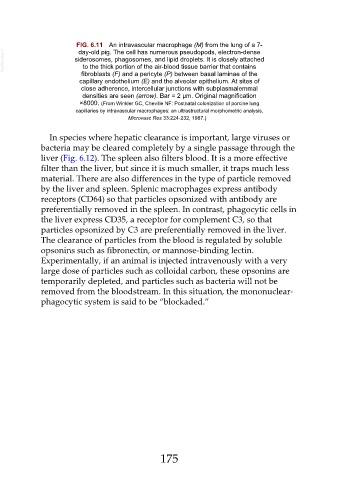Page 175 - Veterinary Immunology, 10th Edition
P. 175
FIG. 6.11 An intravascular macrophage (M) from the lung of a 7-
VetBooks.ir siderosomes, phagosomes, and lipid droplets. It is closely attached
day-old pig. The cell has numerous pseudopods, electron-dense
to the thick portion of the air-blood tissue barrier that contains
fibroblasts (F) and a pericyte (P) between basal laminae of the
capillary endothelium (E) and the alveolar epithelium. At sites of
close adherence, intercellular junctions with subplasmalemmal
densities are seen (arrow). Bar = 2 µm. Original magnification
×8000. (From Winkler GC, Cheville NF: Postnatal colonization of porcine lung
capillaries by intravascular macrophages: an ultrastructural morphometric analysis,
Microvasc Res 33:224-232, 1987.)
In species where hepatic clearance is important, large viruses or
bacteria may be cleared completely by a single passage through the
liver (Fig. 6.12). The spleen also filters blood. It is a more effective
filter than the liver, but since it is much smaller, it traps much less
material. There are also differences in the type of particle removed
by the liver and spleen. Splenic macrophages express antibody
receptors (CD64) so that particles opsonized with antibody are
preferentially removed in the spleen. In contrast, phagocytic cells in
the liver express CD35, a receptor for complement C3, so that
particles opsonized by C3 are preferentially removed in the liver.
The clearance of particles from the blood is regulated by soluble
opsonins such as fibronectin, or mannose-binding lectin.
Experimentally, if an animal is injected intravenously with a very
large dose of particles such as colloidal carbon, these opsonins are
temporarily depleted, and particles such as bacteria will not be
removed from the bloodstream. In this situation, the mononuclear-
phagocytic system is said to be “blockaded.”
175

